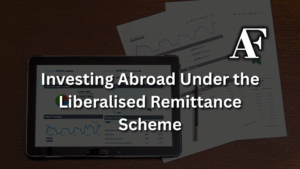The Liberalised Remittance Scheme (LRS) provides Indian residents with a structured yet flexible pathway to invest abroad. Families can pool their individual limits for joint ventures, while each member retains independent accountability.
There is no restriction on the number of remittances, provided the annual ceiling of USD 250,000 is respected. A valid PAN is mandatory for all transactions.
This guide covers all the essential aspects of how to invest abroad under the LRS.
My contact details are hello@adamfayed.com and WhatsApp +44-7393-450-837 if you have any questions.
The information in this article is for general guidance only. It does not constitute financial, legal, or tax advice, and is not a recommendation or solicitation to invest. Some facts may have changed since the time of writing.

What is the LRS for overseas investment?
The Liberalised Remittance Scheme or LRS is a comprehensive foreign exchange policy framework introduced by the Reserve Bank of India (RBI) in 2004.
Under this scheme, resident Indians, including minors, are permitted to freely remit up to USD 250,000 per financial year (April to March).
This applies to any permissible current or capital account transaction or a combination of both.
This is to facilitate outward remittances by resident individuals without requiring prior RBI approval.
The LRS has gained significant importance for resident Indians seeking to diversify their investment portfolios globally and access international markets.
It represents one of the most liberal foreign exchange frameworks under the Foreign Exchange Management Act (FEMA), 1999.
Thus, enabling individuals to participate in global financial opportunities while maintaining regulatory compliance.
The scheme applies exclusively to resident individuals as defined under FEMA 1999 and is not available to corporates, partnership firms, Hindu Undivided Families (HUFs), or trusts.
This individual-centric approach ensures that personal wealth diversification and international exposure remain accessible to Indian residents within prescribed regulatory boundaries.
What is permitted under a Liberalized Remittance Scheme?
The LRS framework permits a comprehensive range of investment options for resident Indians looking to diversify their portfolios internationally:
Equity and Securities Investments
Purchase of shares in both listed and unlisted overseas companies, debt instruments, and qualification shares for directorship positions.
Investors can also acquire shares as compensation for professional services or directors’ remuneration.
Mutual Funds and Alternative Investments
Investment in units of overseas mutual funds, venture capital funds, alternative investment funds (AIFs), and unrated debt securities, including promissory notes.
Real Estate Investments
Acquisition of immovable property abroad, subject to compliance with the Overseas Investment Rules, 2022.
Multiple family members can consolidate their LRS limits for larger property purchases, provided the property is held in joint names proportionate to individual contributions.
Business Ventures
Setting up Wholly Owned Subsidiaries (WOS) and Joint Ventures (JV) outside India for bona fide business purposes, subject to specific terms and conditions stipulated under overseas investment guidelines.
Financial Services
Opening foreign currency bank accounts abroad without RBI approval, facilitating seamless international transactions, and investment management.
Loan Extensions
Extending interest-free loans in Indian Rupees to Non-Resident Indian (NRI) or Person of Indian Origin (PIO) close relatives, with a minimum maturity of one year.
What are the prohibited transactions under LRS?
The RBI has explicitly prohibited certain categories of transactions under the LRS to prevent capital flight for undesirable purposes and maintain financial stability:
Restricted Jurisdictions
Capital account transactions made directly or indirectly to countries or territories identified by the Financial Action Task Force (FATF) as non-cooperative or high-risk for money laundering and terrorist financing.
Speculative Activities
Remittances for lottery tickets, gambling, betting activities, or any form of speculative trading that violates RBI norms.
This includes margin trading, forex trading for speculative purposes, and cryptocurrency transactions.
Prohibited Current Account Transactions:
Any current account transactions banned under Schedule I or restricted under Schedule II of the Foreign Exchange Management (Current Account Transactions) Rules, 2000.
Terrorism-Related Activities:
Remittances to individuals or organizations supporting acts of terrorism, as separately advised by the Reserve Bank to authorized dealer banks.
Real Estate Business Restrictions:
While property purchase is permitted, remittances for real estate business activities (except townships and residential buildings) are prohibited.
Agricultural and Trading Restrictions:
Investments in agriculture, plantation activities, Nidhi companies, chit funds, and trading in Transferable Development Rights (TDRs) are not permitted.
How to invest abroad using LRS?
The process of investing overseas under the LRS involves a streamlined procedure:

Step 1: Bank Selection and Application
Choose an RBI-authorized dealer (AD Category-I bank) or licensed fintech platform and submit the completed Form A2 application-cum-declaration.
Step 2: Documentation
Provide mandatory documents, including:
- PAN card (compulsory for capital account transactions)
- KYC documents
- Income proof
- Specific investment-related documentation
Step 3: Purpose Code Declaration
Select the correct RBI purpose code corresponding to your investment type to ensure regulatory compliance.
Step 4: Bank Verification
The authorized dealer conducts due diligence, verifies LRS limit availability, and ensures the transaction falls within permissible categories.
Step 5: Fund Transfer
Upon approval, funds are converted to the desired foreign currency and transferred to the overseas investment account or beneficiary.
The entire process typically takes 1-3 business days for completion, with banks required to report transactions to RBI on a daily basis.
LRS Compliance & Documentation Requirements
The LRS framework mandates comprehensive documentation and compliance procedures to ensure regulatory adherence and prevent misuse:
- Mandatory PAN Requirement: A PAN card is compulsory for all capital account transactions under LRS. For current account transactions up to USD 25,000, PAN may not be insisted upon.
- Form 15CA/15CB Requirements: For remittances exceeding Rs 5 lakh annually to non-residents or foreign companies that are taxable in India, Form 15CA must be filed. This should be done along with Form 15CB certification by a Chartered Accountant.
- AD Bank Verification Process: Authorized dealers must review bank statements for the previous year to verify the source of funds. Where bank statements are unavailable, the latest income tax assessment order must be obtained.
- Application Form A2: Every outward remittance requires submission of Form A2 (Application-cum-Declaration for Foreign Exchange), regardless of the amount. This form captures remitter details, purpose, beneficiary information, and declaration of compliance.
- Frequency and Reporting: There are no restrictions on the frequency of remittances within a financial year, but the cumulative amount cannot exceed USD 250,000. Banks report transactions daily to the RBI through the CIMS system.
- Credit Facility Restrictions: Banks are not permitted to provide any credit facility (funded or non-funded) for remitting funds under LRS for capital account transactions, though current account remittances may be facilitated through credit arrangements.
Family-Based Investments under LRS Scheme
- Individual Limits: Each resident has an independent USD 250,000 annual cap, so a family of four can collectively remit up to USD 1 million.
- Consolidation: Family members may pool limits for joint investments like property or businesses, but each must remain a co-owner in proportion to their contribution.
- Restrictions: One member cannot use another’s quota without joint ownership; gifting of limits is not allowed.
Intermediaries may be used, but compliance must remain individual.
Management of Overseas Investment Under the LRS
- Foreign Accounts: Residents can open and maintain foreign currency accounts abroad to manage investments.
- Income Retention: Dividends, rent, and interest may be retained and reinvested abroad without affecting LRS limits.
- OBU Limitation: Offshore Banking Units in India are not considered overseas branches for LRS accounts.
- Transaction Oversight: Banks must record and report all LRS transactions daily to the RBI.
- Currency Options: Remittances may be made in any freely convertible currency, not just USD.
LRS Restrictions on Instruments & Credit Facilities
The Liberalised Remittance Schemeplaces clear limits on what instruments and credit facilities investors can use.
- Permissible Assets: Investments are allowed in securities, bonds, mutual funds, and real estate; speculative and derivative trading is barred.
- Debt & Equity: No fixed ratio prescribed, but speculation is restricted.
- No Credit Support: Indian banks cannot extend credit for overseas investments under LRS.
- Collateral Limits: LRS investments cannot be pledged for loans in India.
- No Leverage: Margin trading and leveraged transactions are not permitted.
Are resident individuals required to repatriate the accrued interest dividend on deposits/investments abroad over and above the principal amount under LRS?
Under current LRS regulations, resident individuals who have remitted funds for overseas investments enjoy significant flexibility in managing investment returns:
Income Retention:
Investors can retain and reinvest income earned on LRS investments abroad, including dividends, interest, and rental income, without mandatory repatriation to India.
Reinvestment Freedom:
The 180-day repatriation rule that applies to some foreign exchange transactions does not extend to income generated from LRS investments.
Therefore, allowing investors to compound their overseas wealth.
LRS Limit Calculation:
Income earned on existing LRS investments is not counted toward the annual USD 250,000 limit, enabling investors to remit fresh funds while retaining overseas earnings.
Overseas Direct Investment Compliance:
However, individuals must comply with specific overseas investment guidelines and reporting requirements in certain cases.
For example, it applies to those who have made overseas direct investments in equity shares or compulsorily convertible preference shares of joint ventures or wholly owned subsidiaries.
Repatriation Upon Return:
While income can be retained abroad, any unrealized or unused foreign exchange must be repatriated and surrendered to an authorized dealer within 180 days.
This is the case if the investor returns to India or the investment is liquidated.
What are the conditions for an Indian party to make an investment in an overseas joint venture or wholly owned subsidiaries?
Investment in overseas joint ventures or wholly owned subsidiaries under LRS is subject to stringent conditions:
- Investments are limited to the LRS annual limit of USD 250,000 per individual, unlike corporate overseas investments, which can extend up to 400% of net worth.
- The overseas entity must be established for legitimate business activities and comply with local regulatory requirements in the host country.
- Investment can be funded through foreign exchange from authorized dealer banks in India, with no credit facility extension by Indian banks for such investments.
- Investors must file Annual Performance Reports (APR) based on audited or unaudited financial statements of the investee company by December 31 each year. They should be filed separately from Foreign Liability and Asset (FLA) returns.
- While individuals use Form A2 under LRS, they must still comply with the broader overseas investment guidelines.
And, they may need to submit additional documentation as prescribed under overseas investment regulations.
The overseas entity must comply with all local laws, regulations, and reporting requirements of the jurisdiction where it is established.
Practical Considerations for Indian Investors
- Currency Risk: Forex volatility can impact returns, making hedging important.
- Tax Collection at Source (TCS): NIL up to ₹10 lakh, 5% for education/medical beyond that, and 20% for other remittances including investments.
- Compliance Records: Proper documentation of remittances and performance is essential for tax and regulatory purposes.
- Global Exposure: Investors face risks from foreign markets, regulations, and geopolitics.
- Costs: Conversion charges, transfer fees, and brokerage costs affect net returns.
- Taxation: Overseas gains may be taxed both abroad and in India, requiring DTAA use to avoid double taxation.
Conclusion
The Liberalised Remittance Scheme represents a significant liberalization measure that enables resident Indians to participate in global markets and diversify their investment portfolios beyond domestic boundaries.
With an annual limit of USD 250,000 per individual, the scheme facilitates access to international equity markets, real estate, mutual funds, and business opportunities.
Key benefits include portfolio diversification, currency hedging opportunities, access to global growth markets, and the flexibility to retain and reinvest overseas income.
The scheme’s family consolidation provisions allow larger investments through combined limits, making substantial international transactions feasible for Indian families.
However, successful overseas investing under LRS requires careful planning and compliance with documentation requirements, understanding of tax implications, and awareness of currency and market risks.
Pained by financial indecision?

Adam is an internationally recognised author on financial matters with over 830million answer views on Quora, a widely sold book on Amazon, and a contributor on Forbes.



